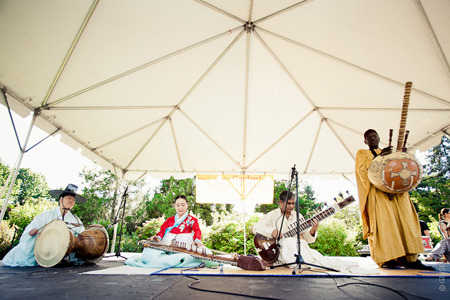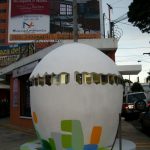Con Edison Immigrant Artist Program Newsletter, Issue No. 40
Featured Organization: Queens Botanical Garden
Queens Botanical Garden (QBG) began in 1939 at the New York World’s fair in Queens, and has gone through some of its most radical changes in recent years. In 2007 they opened their new visitor center, the greenest building in New York at the time with a “platinum” LEED rating. They have expanded their programming to encompass school, community, and intergenerational education and cultural events, such as free, public concerts that showcase the diverse heritage of the Queens immigrant community.
The NYFA Folk Artist Development Program recently partnered with QBG on September 15th for The Gift of Wisdom as part of Locating the Sacred Festival. NYFA Immigrant Artist Program Officer Karen Demavivas and Intern Aya Sato talk to QBG’s Director of Marketing and Development Darcy Hector about the most recent cultural and environmental endeavors of QBG.
In your words, what would you say is the mission and role of Queens Botanical Garden?
Queens Botanical Garden is “the place where people, plants, and cultures meet.” When the Master Plan was developed, Garden leadership deliberately sought out the input of the community, which is heavily immigrant, as to the direction they wanted the Garden to develop. They completed the Master Plan in 2001. It outlined a vision for a Garden built around the universal themes of water and the presentation of plants as unique expressions of cultural traditions. The Mission Statement reads : “Queens Botanical Garden is an urban oasis where people, plants and cultures are celebrated through inspiring gardens, innovative educational programs and demonstrations of environmental stewardship.” The Garden’s role in the community, as an environmental leader, an educator, and a meeting ground for all cultures is well encapsulated in that statement.
The programming at QBG really encompasses the diverse immigrant population of Queens. What are some ways in which you collaborate with the immigrant communities in the area?
The Garden serves a wide range of people from literally every corner of the earth. We strive to present beautiful plantings and engaging events that will appeal and bring people to the Garden. Because the needs and desires of the surrounding communities helped shape the Master Plan, collaboration with immigrant communities is “baked in” to QBG’s programmatic philosophy. The QBG Tai Chi Group, 100-200 individuals who meet every morning in the Garden, for example, is not a special program for immigrants but rather part and parcel of QBG. In some cases, we present performing artists from a particular culture. In other cases, we collaborate with a cultural group to present a significant cultural event such as the Lunar New Year Flower Market, which drew Chinese visitors, or the Diwali Festival, a favorite of Indian audiences. We also operate a number of community service projects with groups such as the Korean Community Service Society and the Hindu Temple Society.
We try very hard to be welcoming and accessible to all. Our latest innovation in service of this goal is an Ipad translation system for our lobby, which allows translation of not just Chinese, Korean, Hindi, Urdu, Spanish, Greek, Russian and Yiddish, but a total of 120 languages!

In recent years, a lot of work has been put into sustainability at QBG. What are the fruits of these labors? Are there any current projects you could share with us?
As an organization, we continue to reap the environmental and economic benefits of operating a LEED-platinum certified building – we use only 40% of the energy and 20% of the water as a conventionally designed building of the same size. More importantly, though, is the role sustainability plays in our education programs. We operate an active and popular Composting Project that has trained thousands of local residents in the “whys” and “hows” of urban composting. Our Environmental Education Workshops for school children bring some 16,000 students to the Garden each year. Sustainability is also a key ingredient in the professional development workshops QBG offers teachers. The Green Jobs program QBG launched this past fall is wonderfully cost-effective. It uses the existing resources of QBG staff expertise in sustainability, our grounds and buildings, along with the strength of our partner LaGuardia Community College in supporting workplace entry. More than 100 people are now employed as a result of this program and others continue to be added to the workforce. Let it not be said that we cannot “afford” to protect our environment! Working to raise awareness of environmental stewardship has enormous benefits for the community as a whole, as can be seen in QBG’s work in education, workforce development, and the creation of “social capital” within a demographically fast-changing borough.
With respect to current projects connected with QBG’s sustainability vision, in addition to Green Jobs mentioned above, even more recently launched is the Intergenerational Garden and Food Pantry Project. Led by Maureen Regan, the Intergen Garden brings together community members of a wide range of cultures and ages to raise organic produce for their own use as well as local food pantries and soup kitchens. The recipients of the produce are often immigrant social service organizations, such as womens’ shelters that primarily serve a particular language group. It is extremely gratifying to be able to respond to the immediate needs of the community while teaching the next generation of gardeners. Indeed, many studies have pointed to the fact that ethnically mixed communities live in peace to the extent to which they mingle and share social space.
Could you talk about QBG’s work with the NYFA Folk Artist Development Program, for the Gift of Wisdom showcase? What kinds of organizations do you often collaborate with, and for what kinds of ventures?
I first met Karen Demavivas of NYFA’s Immigrant Artist Project at a meeting of the Queens Borough President’s Immigrant Task Force. QBG had recently presented one of the artists that was ultimately selected as a Master Artist by the NYFA Folk Artist Development Program, Master Yoon-Sook Park. It was apparent to both Karen and me that QBG and NYFA were natural partners in the realm of immigrant artists (and elsewhere, as well!) A few months later the plans for the Locating the Sacred Festival were being discussed and QBG was very pleased to be brought in during the early stages. We were delighted to be an early partner with the Asian American Arts Alliance and NYFA in this remarkable festival. Working with the NYFA Folk Artist Development Program led to this wonderful event on September 15th: a presentation of Master Soon Yook Park playing the kayagum(Korean zither) along with classical Indian dancer Mala Desai, sitarist Ikhalq Hussaim, and Alhaji PapaSussa on the kora(African harp-lute). It is an amazing and inspiring line-up.
We collaborate with other partners as well. For example, on September 30 we are co-presenting an Autumn Moon Festival celebration with the New York Chinese Cultural Center. In Flushing, Autumn Moon is a prominent Chinese holiday that has traditionally been celebrated at QBG because the immediate neighborhood is heavily Chinese. In other years there have been other partners. The Garden is a natural setting for many of these kinds of events and we do our best to collaborate to create a successful celebration.
What are some of the ways in which QBG supports and works with New York artists in general?
We present artists through our Music in the Garden series of outdoor summer concerts. Given the surrounding community, these performances often feature immigrant performers, some working in traditional styles, and others in a more contemporary vein. Last year we presented a program of Classical Indian dance but also the Indian performing group Charanams. Charanams won the WNYC “Best of the Borough” award in 2011 and has a unique jazz-infused sound. Korean, Chinese and South American performers were also presented by QBG last season. This year we presented the folkloric Mexican ensemble Radio Jarocho as well as a concert of pop tunes by the band Earth. Both these concerts brought out an amazing mix of people. In other cases, we work with outside organizations to provide a platform for artists. For example, our presentation of the dance company BodyArt earlier this year was part of the QAX Festival and the June Quintet of the Americas concert was co-sponsored by the Latin American Cultural Center of Queens.
Our Gallery hosts four annual exhibitions. While there is no hard and fast policy in place, we have largely presented Queens artists and shows dealing with the local area. In the past, the Garden has hosted artists-in residence with excellent results. We expect to host such artists again in the near future. Finally, but not inconsequentially, the Garden serves as an inspiration for many an artist, and as a workshop for many a photographer or sketcher.





